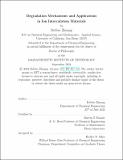| dc.description.abstract | Lithium ion batteries (LiBs) are a pivotal energy storage technology that are widely adopted for their high energy density and safety. From a macroscopic level, LiBs operate at a micrometer lengthscale, but consist of many active material nanoparticles which participate in reversible electrochemical reactions that store and release energy. These particles control the crucial processes for energy storage in macroscopic devices, generating a process spanning multiple length and time scales in LiBs. However, despite the ubiquitous application of LiBs in many industries, degradation limits their lifespan, hindering their broader applicability in usages demanding high energy density and extended lifespans, such as electric vehicles (EVs). Dominant degradation occurs at the nanoparticle level involving various mechanisms, such as formation of resistive films on the particle surface or surface phase transformations in common LiB materials. The effects of degradation are observed at the macroscopic level from electrochemical responses such as voltage or current measurements. Bridging the gap between microscopic and macroscopic scales to extract particle level degradation mechanisms from electrode scale responses is essential for understanding LiB degradation. These methods can be used to quantify degradation in battery materials for second life use, designing degradation resistant materials, and more.
Here, I propose a comprehensive multiscale framework that initially models LiB degradation at a single particle scale, using nickel rich materials as an example, then projects single particle degradation into population scale for both solid solution and phase separating materials. Furthermore, I analyze and design improved pulse diagnostics using hybrid pulse power characterization (HPPC) methods to extract physical microscopic degradation mechanisms from electrode-level responses. Overall, I set up a consistent framework modeling degradation from single particle to population level and vice versa in LiBs. | |
